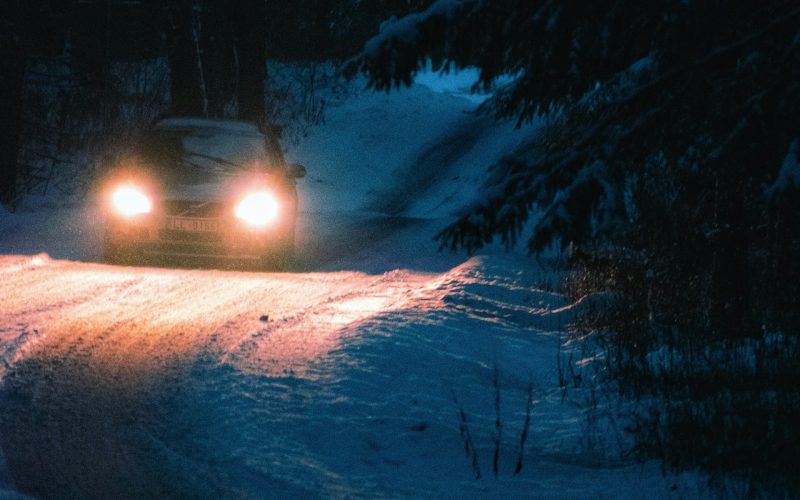Winter roads bring ice, fog, and shorter daylight hours. These conditions test every driver’s preparation and patience. A car that runs perfectly in summer can struggle when temperatures drop below freezing, and a routine commute can turn hazardous if tyres lose grip or visibility falls to a few metres.
Preparing your vehicle and adjusting your driving style can make a real difference to your safety and confidence during the colder months. Small actions taken before you set off can prevent breakdowns, collisions, and stress.
Check Your Tyres and Tread Depth
Tyres are your only contact with the road surface. Worn tread reduces grip on wet or icy tarmac and increases stopping distances. The minimum legal tread depth is 1.6 millimetres, but many motoring organisations recommend at least 3 millimetres for winter driving.
Check tyre pressure regularly. Cold air causes pressure to drop, and under-inflated tyres wear unevenly and handle poorly. Your vehicle handbook shows the correct pressure for front and rear tyres. Inspect the sidewalls for cuts or bulges, and replace any tyre that looks damaged.
If you live in an area with frequent frost or snow, consider switching to winter tyres. They use a softer rubber compound that stays flexible in low temperatures and provides better traction. All-season tyres offer a middle ground for drivers who face mixed conditions.
Prepare Your Battery and Fluids
Cold weather puts extra strain on your battery. If it is more than five years old, have it tested. A weak battery may start your car on a mild day but fail completely on a freezing morning.
Top up your windscreen washer fluid with a solution that includes antifreeze. Plain water will freeze in the reservoir and pipes, leaving you unable to clear dirt or salt spray from the glass. Check your coolant level and make sure the mixture is strong enough to protect the engine in sub-zero temperatures.
Oil becomes thicker in the cold, making it harder for the engine to turn over. If your oil is due for a change, do it before winter arrives. Fresh oil flows more easily and protects engine parts during those first few seconds after a cold start.
Improve Visibility and Lighting
Shorter days mean you will drive in the dark more often. Clean your headlights, tail lights, and indicators. Dirt and grime reduce the brightness of your lights and make it harder for other drivers to see you.
Replace any blown bulbs immediately. Check that your fog lights work, but remember to switch them off when visibility improves. Leaving them on in normal conditions can dazzle other road users and may result in a fine.
Inspect your windscreen wipers. Rubber blades that are cracked or torn will smear water and leave streaks. New blades are inexpensive and take minutes to fit. Keep a scraper and de-icer in the car so you can clear frost and ice quickly without damaging the glass.
Adjust Your Driving Style
Ice and snow demand smoother inputs. Accelerate gently, brake earlier, and steer with care. Sudden movements can break traction and cause a skid. Increase your following distance to at least four seconds, and double that if the road is icy.
Use the highest gear possible without labouring the engine. This reduces the chance of wheelspin on slippery surfaces. If you do start to skid, ease off the accelerator and steer in the direction you want to go. Avoid harsh braking, which can lock the wheels.
Black ice is almost invisible and forms in shaded areas, on bridges, and under trees. If the road looks wet but other cars are not leaving spray, treat it as ice. Slow down well before bends and junctions, and test your brakes gently on a straight, empty stretch to get a feel for the grip.
Plan Your Journey and Carry Essentials
Check the weather forecast and road conditions before you leave. If a severe weather warning is in place, consider postponing your trip or using public transport. Tell someone your route and expected arrival time if you must travel.
Keep an emergency kit in the boot. Include a blanket, torch, high-visibility vest, first-aid kit, and some snacks. A fully charged mobile phone is important, but a portable charger adds extra security. A small shovel and a bag of sand or cat litter can help if you get stuck in snow.
Fill your fuel tank before it drops below half. Running low increases the risk of fuel line freeze, and you may need to keep the engine running for warmth if you are delayed. A full tank also adds weight over the rear wheels, which can improve traction in rear-wheel-drive vehicles.
Understand How Winter Conditions Affect Insurance Claims
Driving in poor weather does not automatically invalidate your cover, but insurers will look closely at the circumstances of any collision. If you were driving too fast for the conditions or had bald tyres, you may face questions about whether you took reasonable care.
A claim for a winter accident can affect your no-claims bonus and push up your premium at renewal. Some policies offer no-claims protection, which allows one claim without losing your discount. Check your certificate to see if this feature is included or available as an optional extra.
Dashcam footage can support your version of events if another driver caused the collision. It shows road conditions, visibility, and the actions of all parties. Many insurers now ask if you have a dashcam fitted, and some offer a small discount if you do.
Stay Informed and Drive with Confidence
Winter driving requires preparation and patience. A few simple checks before you set off can prevent breakdowns and improve your safety. Adjusting your speed and driving style to match the conditions protects you and everyone else on the road.
Carrying emergency supplies and planning your route gives you peace of mind. If conditions are too dangerous, it is always better to delay your journey than to take unnecessary risks.
Taking these steps helps you stay safe and in control throughout the colder months. For more detailed advice on preparing your vehicle and staying protected, read our winter driving safety tips to help you handle challenging conditions with confidence.









